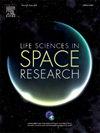Prolonged exposure to centrifugal acceleration increases biomass and alters biomass allocation in Arabidopsis thaliana (L.) Heynh. with no apparent impact on elemental concentration in the shoot system
IF 2.8
3区 生物学
Q2 ASTRONOMY & ASTROPHYSICS
引用次数: 0
Abstract
Previous studies have shown that plants can complete their life cycle under microgravity. However, the effects of long-term exposure to altered gravity conditions, including microgravity, on most of the biological processes of a plant's life cycle remain largely unexplored. Given the limited opportunities for space experiments, ground-based experiments using altered gravity conditions have been conducted. To investigate the longer-term effects of centrifugal acceleration, we have developed and utilized a custom-built centrifugal cultivation system using a centrifuge equipped with lighting, enabling the continuous growth of seed plants under centrifugal acceleration. In this study, we examined the effects of 10 g centrifugal acceleration on the biomass of the shoot system (stems and rosette leaves) and the root system of Arabidopsis thaliana for the first time, covering the entire cultivation period from germination to 40 days. Our results showed that the dry mass of the stem per unit length was significantly larger under 10 g compared to the 1 g control, indicating a typical gravity resistance response of the stem. Moreover, the total dry mass of the stems, rosette leaves, and roots was larger under 10 g centrifugal acceleration compared to the 1 g control, suggesting an increase in biomass at the individual plant level. We also observed that the leaf mass per area of the rosette leaf was larger under centrifugal acceleration compared to the 1 g control, indicating enhanced photosynthesis rates in Arabidopsis and resulting in increased biomass of individual plants. In terms of biomass allocation, both root-shoot ratio and root mass fraction were significantly higher under centrifugal acceleration compared to the 1 g control. Furthermore, we measured the concentration of mineral elements in the main stem and rosette leaves using inductively coupled plasma optical emission spectrometry. Despite the increase in dry mass of the root system, we found no significant differences in the concentration of any of the ions between 10 g and 1 g conditions, indicating that mineral nutrient uptake homeostasis is maintained even under centrifugal acceleration.
长时间暴露于离心加速下,拟南芥生物量增加,生物量分配发生改变。Heynh。对茎系元素浓度无明显影响
以前的研究表明,植物可以在微重力下完成它们的生命周期。然而,长期暴露在改变的重力条件下,包括微重力,对植物生命周期的大多数生物过程的影响在很大程度上仍未被探索。由于空间实验的机会有限,利用改变的重力条件进行了地面实验。为了研究离心加速的长期影响,我们开发并使用了一种定制的离心培养系统,该系统使用配备照明的离心机,使种子植物在离心加速下持续生长。本研究首次研究了10 g离心加速度对拟南芥(Arabidopsis thaliana)茎部(茎和莲座叶)和根系生物量的影响,覆盖了从萌发到40天的整个培养期。结果表明,在10 g条件下,茎的单位长度干质量明显大于1 g,表明茎具有典型的重力阻力响应。此外,在10 g离心加速度下,茎、莲座叶和根的总干质量比1 g对照大,表明单株生物量增加。我们还观察到,与1 g的对照相比,在离心加速下,莲座叶的单位面积叶质量更大,这表明拟南芥的光合速率提高,导致单株生物量增加。在生物量分配方面,离心加速处理下的根冠比和根质量分数均显著高于1 g对照。此外,我们还利用电感耦合等离子体发射光谱法测定了主茎和莲座叶中矿物元素的浓度。尽管根系干质量增加,但我们发现在10g和1g条件下,任何离子的浓度都没有显著差异,这表明即使在离心加速下,矿物质营养吸收也能保持稳态。
本文章由计算机程序翻译,如有差异,请以英文原文为准。
求助全文
约1分钟内获得全文
求助全文
来源期刊

Life Sciences in Space Research
Agricultural and Biological Sciences-Agricultural and Biological Sciences (miscellaneous)
CiteScore
5.30
自引率
8.00%
发文量
69
期刊介绍:
Life Sciences in Space Research publishes high quality original research and review articles in areas previously covered by the Life Sciences section of COSPAR''s other society journal Advances in Space Research.
Life Sciences in Space Research features an editorial team of top scientists in the space radiation field and guarantees a fast turnaround time from submission to editorial decision.
 求助内容:
求助内容: 应助结果提醒方式:
应助结果提醒方式:


